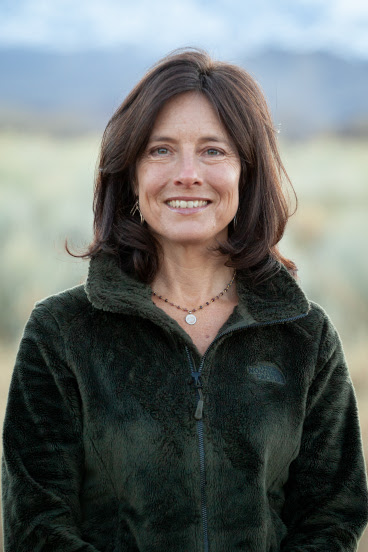 | Volume 1 - Issue 4
Mid-September 2021 | |  | The Keep Long Valley Green Coalition —Working for Equitable Water Sharing in the Eastern Sierra By Wendy Schneider, Executive Director, Friends of the Inyo This column was originally published earlier this month in the official e-newsletter and blog of Walking Water (www.walking-water.org), which, like KLVG, is working to achieve water justice, but whose scope extends beyond the Eastern Sierra to other parts of the United States and the world. | | | | | | U.S. Geological Survey Map Brief History In the 1940’s as part of its construction of the Los Angeles Aqueduct system (LAA), the Los Angeles Department of Water and Power (LADWP) constructed Crowley Lake Dam and flooded the area west of the dam, creating Crowley Lake. This action resulted in the destruction of the wetland meadows that had previously comprised the area. Following the destruction of these wetland meadows, the agency began allowing ranchers to irrigate areas around the newly created Crowley Lake. Until recently, ranchers had been allotted sufficient amounts of water for their agricultural operations, which also resulted in the creation of wetland meadows. These new wetland meadows mitigated, to a certain extent, the damage LADWP did to the area when it destroyed the wetland meadows that had existed on the current site of Crowley Lake. In 2018, LADWP notified ranch leaseholders in the area that it intended to remove all irrigation water from future leases. The agency took this shocking and unprecedented action without performing any study or analysis of this proposal’s impact on Long Valley’s environment, agricultural and recreational economies, the health and safety of local communities, or any other potential effect, as required by law. LADWP’s proposed de-watering would have resulted in the loss of the wetland meadows in Long and Little Round Valleys, causing many negative impacts. Some of these impacts are environmental, the meadows support a variety of invertebrate, amphibian, and avian life, including the native Bi-state Sage Grouse, a species of special concern. The meadows also decrease the risk of wildfire and suppress dust for local communities, and sequester carbon to mitigate climate change impacts. Some of the negative impacts would be economic, as the meadows support the local ranching and recreational tourism economy. | | | | | | The Keep Long Valley Green Coalition In response to DWP’s proposed de-watering a variety of local stakeholders joined together to form the Keep Long Valley Green Coalition. Over the last 24 months, I have had the privilege of working with the Keep Long Valley Green Coalition. The coalition is refreshingly diverse, composed of local ranchers, tribes, recreationists, and environmentalists. Folks employed by Inyo and Mono Counties, and a representative from the Great Basin Unified Air Pollution Control District often join our calls. Initially, our coalition goals were limited to ensuring an adequate and regular supply of water to southern Mono County. In 2020, however, we decided to engage in LADWP’s legally mandated process of updating its Urban Water Management Plan. Our coalition put together a technical comment letter, supported by the collective expertise of our coalition, that demonstrated that, based on DWP’s own data, the agency could serve the needs of its ratepayers while substantially reducing the amount of water it extracted from Payahuunadu. The coalition enjoyed validation and momentum in late 2019 when the Alameda County Superior Court ruled that DWP could not simply unilaterally abandon historic irrigation practices in Long and Little Round Valleys and withhold water supplies needed to maintain the meadows. Instead, the Court ruled that before LADWP could make substantial changes to its practices, the agency must perform an environmental review as required by the California Environmental Quality Act. In spite of the fact that, since the ruling, DWP representatives have orally committed to folks here in the Eastern Sierra that it will not ever again seek to disallow irrigation in Long and Little Round Valleys, the agency appealed the ruling. What the KLVG Coalition asks of LADWP - Commit to provide water to Little Round and Long Valleys, each year, pursuant to a formula tied to each year’s snowpack.
The above request is almost identical to the Court’s order from Mono County and the Sierra Club’s successful litigation. That is, the Court ordered DWP to continue allowing historic irrigation levels, every year, based on water availability, which is determined by the snowpack. Even so, the agency has steadfastly refused to even consider making this reasonable commitment. The refusal is especially puzzling because the agency’s usual practice (prior to 2018) was to adjust the amount of irrigation water provided to the area based on each year’s unique snowpack. So why not simply commit to follow this practice in perpetuity, as ordered by the court? - Commit to substantially reduce water extraction via the LAA over the next 30 years.
The conservation achievements of the people of Los Angeles in recent decades are truly stunning. Further, the LA Mayor’s office is committed to capture, recycle, and use local storm and groundwater, and has made significant progress toward these goals. In spite of these things, LADWP, in its 2020 draft Urban Water Management Plan, indicated it has no intention of substantially reducing water exports from the Eastern Sierra over the next 25 years. As with the agency’s refusal to commit to follow its own historic practices in Long Valley, the refusal to commit to reduce water imports from the Eastern Sierra is puzzling: LADWP’s own data and projections, as well as data and projections provided by LADWP staff on “Operation NEXT,” clearly show that LADWP could meet all the water demand needs of the people of Los Angeles AND substantially reduce water exports from the Eastern Sierra. More than 100 years after activation of the LAA, LADWP is clearly aware that the presence (or absence) of water in the Eastern Sierra has a tremendous impact on the health of our environment and the nature and quantity of our economic and recreational opportunities. For all of the area's residents and visitors, and the many species dependent on the meadows in southern Mono County, it is not an overstatement to say that quality of life is heavily dependent on how much of our water LADWP lets us keep each year. | | | | | | Irises in the Long Valley - Photo courtesy of Mammoth Lakes Tourism. How You Can Help Our coalition has found that attempting to influence the behavior of LADWP is frustrating. Neither the LADWP Commissioners, nor the office of the Mayor of Los Angeles who appoints them, are accountable to the people of Payahuunadü/the Eastern Sierra. This makes it very difficult to apply pressure on them to take, or not take, any particular action. The coalition sends letters. Sometimes LADWP politely responds; sometimes not. Our coalition ranchers travel to Los Angeles for meetings. These are polite, but do not lead to the agency taking action on our requests. Our members participate in working groups to protect the sage grouse, but no specific commitments are forthcoming. Nonetheless, the KLVG Coalition is committed to pressuring LADWP to make meaningful changes to its practices in the Eastern Sierra. We have formed a coalition, stood up a website, started a newsletter, and are planning to request meetings with the Commissioners and Mayoral staff. We are also making a movie to tell our story. It will be the latest installation in the long saga of LADWP removing as much water as they can get away with from every corner of Payahuunadü. You can help our coalition move forward in a couple of ways: - Learn the Truth. LADWP is aggressively seeking to promote the narrative that all the problems caused by its water extraction have been solved, and that it is a good steward of the lands of Payahuunadu. This could not be further from the truth. The truth is that DWP is in noncompliance with at least 40 court orders regarding mitigation actions, and is aggressively seeking to increase the amount of water extracts via the LAA. Please sign up to receive our newsletter every other week so you can learn the true facts. https://keeplongvalleygreen.org/join-email/.
- Raise Your Voice. The KLVG Coalition needs stakeholders in Payahuunadü and Los Angeles to let the DWP Commissioners and the Mayor’s office know that you care about the health of the ecosystems in the Eastern Sierra. Please visit our website for instructions on sending your letter to these decision makers. https://keeplongvalleygreen.org/.
| | | | | | We want to hear from you! Get in touch with us at info@keeplongvalleygreen.org with your personal stories of how the LADWP has affected your livelihood, health or well-being. | | | | | | | |